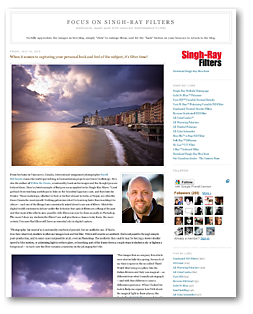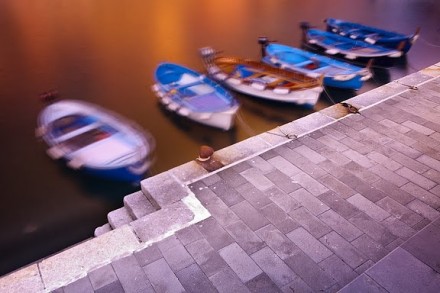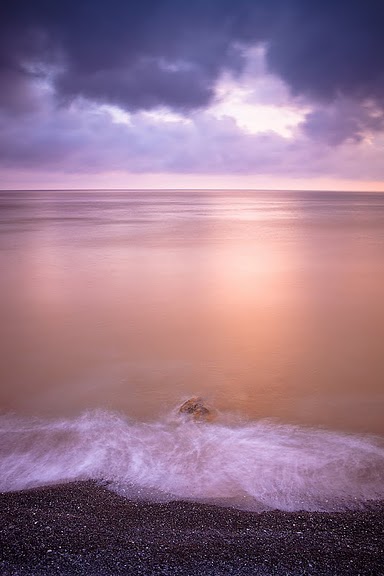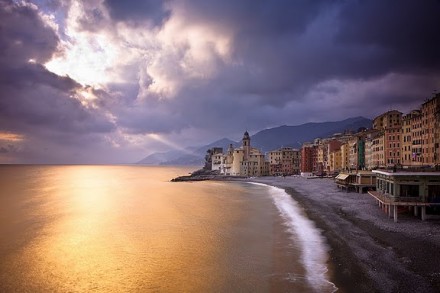
Good news for all my friends and students who have been eagerly chomping at the bit to get their hands on the Singh-Ray Gold-N-Blue Polarizing filter: they’re back in stock. Now I know y’all don’t like these things, and I’m as guilty as anyone of struggling to learn to use this filter a little more judiciously. I also know not everyone is on board with the use of filters at all – last time I posted about this kind of thing someone accused me of lacking integrity – oddly not something I’ve been indicted for when using a 17mm lens or duo-tone treatment on the print. I know, Galen Rowell wouldn’t have done it this way, but then I’m not Galen Rowell. So I’m putting my armour on and cutting/pasting an article that Singh-Ray just released on their blog that has some of my thoughts on the creative use of filters in digital photography. Feel free to disagree if this is one of your weird little hobby horses, but let’s keep the ethical assertions to a minimum. This is art and if you can’t be an anarchist as an artist, you may as well get a job making motivational posters. You do things your way, I’ll do things mine 🙂
From his home in Vancouver, Canada, international assignment photographer David DuChemin roams the world specializing in humanitarian projects and travel workshops. He’s also the author of Within the Frame, a noteworthy book on his images and the thought process behind them. Here’s a brief example of that process as applied to his Singh-Ray filters. “I just got back from teaching workshops in Italy on the beautiful Ligurian coast, and then later in Venice. These workshops, whether in Italy or further abroad in India or Nepal, are often the times I learn the most myself. Nothing galvanizes what I’m learning faster than teaching it to others — and one of the things I am consistently asked about is my use of filters. I think the digital world continues to labour under the delusion that optical filters are a thing of the past and that most of the effects once possible with filters can now be done as easily in Photoshop. The more I show my students the filters I use and give them a chance to try them, the more certain I become that filters still have an essential role in digital capture.
“Photography, for most of us is not merely a technical pursuit, but an aesthetic one. If that is true then what truly matters is what our images look and feel like. Filters still enable an aesthetic that’s not possible through simple post-production, and in some cases not possible at all, even in Photoshop. The aesthetic they enable may be forcing a slower shutter speed to blur motion, or polarizing light to reduce glare, or knocking part of the frame down a couple stops to darken a sky or lighten a foreground — in each case the filter remains a mainstay in the photographer’s kit.
“The images that accompany this article were shot in Italy this spring. So much of my time is spent in the so-called ‘Third World’ that being in a place like the Italian Riviera and Italy was magical — so different from what I usually photograph — and with that difference came a different experience. When I looked for tools to help me express how I felt about the magical light in these places, the Singh-Ray Gold-N-Blue, complete with un-corrected colour cast, was what I settled on for these images. Did it look like that? I’m not sure that’s the point. It felt like that and I’m more interested as a photographer in communicating my own very subjective response to places and moments than I am in pretending at objectivity.
“What the digital world at large has at times failed to recognize are two important understandings. The first is that every technical decision at the point of capture has an aesthetic implication and that means filters will allow you a significantly different look than a mere adjustment layer in Photoshop can replicate. The second is the importance of the creative process itself. Most photographers I know struggle to find a balance between the Artist and the Geek. Optical filters, used well, can meet the needs of both.
“When I made the transition to digital I sold my film gear and a box of filters, most of which I’d never use again even if I had them now. At the time I was told that, ‘you don’t need filters when you shoot digitally.’ I believed it for a long time until I began looking at the work of photographers I really admired – particularly those working in fine art and landscape disciplines. What I saw was a noticeable difference in the aesthetics of their photographs, and it pushed me into what is now nearing the end of a year spent learning about and playing with filters.
“I now carry 2- and 3-stop graduated ND filters (both soft transition and hard transition), a Gold-N-Blue and an LB Warming Polarizer. It’s a small set of filters, and it doesn’t take much room in my bag, but I no longer leave home without them. Together they allow me to capture a broader dynamic range of light, turn mundane light into spectacular light, take longer exposures, and deal with reflections on water. All of that without hours in Photoshop. In fact my images captured with the use of filters consistently need less work in post-production than others. But the biggest benefit my filters have brought me is in service of my creative side, the Artist.
“We all work differently but many of us seem to work dialectically. In other words we begin with A, we react to B, we get C. While this thought process can and does happen in the darkroom, it is much more powerful when used at the point of capture. When you put a filter on the lens you see the results immediately, you react to it, it gives you an idea, helps you see in new ways, and then you change what you’re doing, follow the muse. In my workshops, I’ve seen this process over and over again in my students. They’re shooting a scene, they look at what I’m shooting and exclaim, ‘Wait! How come that looks so different from mine?’ I explain, hand out my filters for them to play with, and watch them run off giggling. The key word in there is ‘play.’ Creativity is one big ‘what if,’ and the more we engage our craft with a sense of play, the more creative and unique our results. Engaging that sense of play is an important step in the creative process, allowing the filters to not only change the way the image looks but to change the very process, making these simple tools a catalyst to in-camera creativity — something Photoshop, for all its marvels, can’t do.”
The Singh-Ray blog is an excellent source of inspiration and information about the use of filters. Find them HERE. As an aside, the year I have spent learning filters has been an interesting one and I’ve waded through a number of frustrations about the differences in sizes and mount-options and it can be confusing at times. Not sure why there can’t be a little more clarity on all this, nor am I sure why some of the best lenses have 82mm threads while Singh-Ray’s screw mounts are sometimes only as large as 77mm. Anyways, I plan to address this kind of thing in an upcoming eBook when I return from Iceland and have a chance to shoot some images to illustrate. Questions about filters – leave ’em here.




Comments
I really want a g’nb pola, but ordering it from The Netherlands it will cost me double. I wish Singh Ray would sell their filters in Europe too, or that Lee makes one. Im a Lee filter and the lovely big stopper user 🙂
Landscape photographer Tony Sweet told me once during a workshop that he will use whatever tools are available to him to make an image. He said. “It’s just how you saw it, only better.” That one simple sentence has stuck with me. I just received my Singh Ray GnB and can’t wait to find the opportunity to use it…
Bravo David
“Did it look like that? I’m not sure that’s the point. It felt like that and I’m more interested as a photographer in communicating my own very subjective response to places and moments than I am in pretending at objectivity.”
Hi David,
Just finished reading Vision Mongers for the first time – wow! Hell of a read, thank you.
Now to filters, do you possess an ordinary polarizing filter as well as the blue gold you discuss here? How do these filters react when people are present – skin tones?
Regards
Paul
@jules – my bad. i hadn’t realised it was a polariser as well (just checked).
but…
given a CPL, *then* can the other stuff be done in PS?
(yeah, yeah, I should let go!)
Pingback: Getting Fun With Plumbing Supplies « Plumbers Brighton
re: 14 “But what does a gold and blue filter do that you can’t do in PS? Or, come to that, how *would* you mimic it in PS?”
I think that you can’t reproduce it after you have inpixelated the scene because your pixels do not know which way the light was polarised, and records it the same (although I suppose someone could develop a sensor that did know!). The blue and gold filter tints the differently polarised light blue and gold. So, for example, a scene with a blue sky and blue water of identical blue, that the pixels would record as identical in hue, can be altered to different hues by the use of the filter. That would be very hard to do in photoshop, wouldn’t it?
P.S. I don’t use photoshop or have a blue and gold filter, just a degree in physics. I am tempted to buy the B&G though, and not so much tempted to waste my life on Photoshop. 🙂
Very useful concept – it didn’t look like that, but it felt like it.
Thanks!
I think everyone knows Singh-Ray makes some of the best filters available. But as a hobbyist photographer, I can’t justify spending that much on a filter. (I REALLY need the polaraizer and graduated ND filters.) Plus, my wife would eviscerate me if she found out I paid that much. So I make do with what I can afford, or even try something crazy like shooting through a pair of polarized sunglasses.
Great work David. If filtration is the way to achieve these results then just go for it.
The buzz filter over here in the UK is the Lee 9 stop ND filter. With this filter you can achieve amazingly long exposures in the middle of the day – read silky smooth water effects. Like the Singh Ray filter it’s not cheap, but it opens up a new set of creative possibilities.
Just where one draws the line in respect of keeping true to the original image is nigh impossible. For example if you don’t measure the colour temperature of the scene with a colour measuring device, but instead set your own kelvin rate, or use auto WB, then straight away your not capturing what was actually there 😉
Thanks, David. Ever practical and logical!
Note–funny how few photos are taken in the rain….and how many more we should be taking!! Great lighting potential, reflections, mood, etc. Your photos nailed it.
By the way, I loved the “Venice” e-book. I’m inspired to tackle a personal project like that….fantastic idea!
Steve – I carried an umbrella. I’ve used all the other solutions and they drive me crazy. Most DSLR bodies are pretty splash resistant – in most cases more splash resistant than I am 🙂 So I carried an umbrella, and a small travel towel to wipe the camera down.
I too would like to get the 82mm version (of the Gold-n-Blue) for my Zeiss 21/2.8 (and then everything else w/ step-down rings) Per an email from Singh Ray about a month ago: “We are working on offering the Gold-N-Blue in an 82mm size as well. As soon as we are able to offer it, it will be available on the website.” Per the same email, the 82mm size in the Vari-N-Duo seems even a more distant dream . . .
David…I ALWAYS download your publications as soon as they come out. However….for some reason, I didn’t read “Venice” until last night. Ties in nicely with this current blog posting, though, so I guess it’s ok.
I have a question about shooting in the rain (as you did in Venice). What, if anything, do you do to protect your camera, lens, and your filters while you’re shooting?
Thanks.
77mm is the filter size for Nikon’s pro lenses, and I think it used to be the pro filter size for Canon before they went to 82mm.
The question I have is how often do you use a gold/blue filter – I’ve happily ordered a LB Warming Polarizer [used to use a Moose one but it broke – they’re rather fragile] but am balking at the cost of a gold/blue – not sure I’d use it enough to justify the $$..?
As the guilty party mentioned in passing here, I feel a bit misunderstood, as well as a bit further along in my growth and understanding since I originally objected to the use of the B&Y filter. The more I see the effect, the more obvious it becomes and the less objectionable it is as a “fraud.”
The picture of the boats above is perfection for me… The dreamy look is obviously not documentary in nature. The odd coloring adds to the effect.
The ocean picture hits me the same way blue screen use in the movies usually does: it screams “something is wrong here” but unless I know specifically what it is, that’s all. I’m probably not artist enough to “get it.”
The city/shoreline picture is the one I objected to at first. I had it as my background for a month, which gave me time to get used to it and try to understand it better. I never grew to love it, but I did grow to accept it for what it is. Maybe if I were to visit and experience Venice…
But the key point is one I agree with wholeheartedly: Filter use is just as important in digital as it was with film.
Hi David,
Thanks for the update. It has really nice to good get them back in stock but they are expensive stuff. And one has to be though-full about their goals to get them. Of coarse the quality is awesome.
David, thanks for this! An ebook about how to use these filters would be invaluable, but with all this discussion about mounts and stacking, …could you make it an ebook/app with book + video demonstration? lol! I would also be interested to learn how you travel with/store them.
I have already reserved a spot on my iBook bookshelf for an Iceland monograph 😉
Do you by chance know how the Singh-ray compares to the Cokin in what it produces? I have a Cokin and have played with it a decent bit but generally get garish with a few exceptions. (as a general rule I know I know cokin sucks Singh Ray good but it was recommended on Luminious Landscape and I gave it a shot.
This article is timely for me. After a few years break I’ve broken down and got a CPL and UV filter, $60 for the pair, Kenko brand, who are Tokina related. I’m not expecting marvels but the quality should at least be decent.
I can see how these two filters affect the quality of light hitting the sensor from a physics perspective.
But what does a gold and blue filter do that you can’t do in PS? Or, come to that, how *would* you mimic it in PS?
And no mention of B+W. Where do they sit in the hierarchy?
Cheers,
I marvel at what filters can do, and I marvel at how much good filters cost. The only thing about filters that really makes me cranky is how difficult it is to use a stack of three of four filters on a 16-35mm lens. Even with 4″x6″ filter sizes, I can’t go wider than about 21mm unless I skip the filter holder and use A-clamps or something to hold all the drop-in filters to the adapter ring.
There are a few pieces of gear that it just makes no sense to go cheap when buying. A tripod is one, and filters is another. Skimp on the camera body, only get 1 or 2 lenses, but don’t waste time with cheap tripods or filters.
Your vision will benefit from spending wisely and keeping things simple.
Enjoy Iceland, David.
It’s funny you talk about Singh-Ray filters now. It was just mid last week that mine had arrived. I got a -2 stop, hard gradient and a -3 solid ND. They were not cheap. Through my experience, you get what you pay for. I know David uses Singh-Ray. I had also read some other blogs about filters and each suggested the same thing, “Don’t bother with the cheaper ones, you will just end up buying the top brand any ways”. So, I took several bloggers advice and got the Singh-Ray filters. If you can’t afford them, don’t settle for cheap brands just save up a little longer for the Singh-Rays.
Why did I get turned on to ND filters? Darwin Wegget. I read his article about how to significantly reducing shutter speeds with ND filters. You can’t reduce shutter speed in Photoshop. Well, you may be able to but that would take a very long time. So, I knew I had to get some ND filters. They have the effect that I was trying to get in my landscape shots but was having little success.
David Hobby also had an article about ND filters. He demonstrated how to use them in mid-day sun to get a shallow depth of field in a portrait shot.
Hey I agree I do it my way you do it yours that’s what makes us artist in our own right. If we all did it the same and subscribed to the same standard or personal ethics we would just be well… Walmart…Kmart and the like.. Love the post..
K
David, could you walk us through when you decide to use the Gold-n-Blue? How do you decide that a scene will look best with this type of filtration? It seems that most pictures that I have seen with this filter involve some sort of water. Are there other uses as well?
Argos – You’re right, they do have a sprocket circular for the P Mount, and I own that one, but I want a larger one – put a polarizer and an ND grad into a P-Size cokin holder on a 82mm wideangle and the vignetting stinks. And you have to use the Cokin P holders which are so junky I feel a rant coming on. I’ve moved up to the larger 100mm filters – easier to handhold and there are better holders available for them – but I still don’t have a G-n-B polarizer I can use with this rig. So I compromise for now – but the 100mm seems to be the pro standard and I’m not sure why we cant just all move on to this bigger size. Anyways, enough whining. Bigger filters mean bigger price tags, so perhaps I should quit while I’m ahead… 🙂
I can’t afford one of those filters, but if I could, I would definitely use it based on your beautiful images.
We homeschool our children, and attend Classical Conversations, a one-day-per-week classical model program. We talk about the dialectic phase of education all the time, but I never thought of what a truly dialectic process photography can be.
David,
You say “…nor am I sure why some of the best lenses have 82mm threads while Singh-Ray’s screw mounts are sometimes only as large as 77mm…” But you can also get the Singh-Ray Gold-n-Blue in a Cokin P-mount, and a P-mount adapter ring up to 82mm.
When I save up enough pennies for a G-n-B, I’ll likely go this way — the darned things are so expensive that I can’t afford to buy more than one (even though I want to use one on a couple of different lenses).
Most of the howls about the use of filters and other expressions of creativity come from within the photographic community by those who seem to me to be locked inside of a box. The general public tends to look at a photograph as a work of art that stands on its own two feet. Yes, we all have our preferences. Some photographs touch me deeply; but that has nothing to do with whether or not filters or plug-ins or (fill in the blank) are used. I think that these photographs here represent some of your finest work. Illegitimi non carborundum – fake Latin (which seems appropriate in this discussion) for “Don’t let the bastards grind you down.”
Pascal – As I recall Cokin has a blue/yellow filter but it is NOT a polarizer so the effect is very different. If can, however, be layered with a polarizer for a similar kind of effect, though I’m not sure if it requires a special polarizer for that or not. Either way I am not sure whether the effect is the same or not. I’ve been generally unimpressed with Cokin quality but haven’t used their filters for years, so it could be that they have improved.
I’ve got the Singh-Ray Gold+Blue Polariser and their vari-ND filter. Both are superb filters (if a little pricey).
However I think I need to practice more on when to use the G&B Polariser as many of the shots I’ve used it on so far either come out overblown or unaffected. I guess like all things its practice!
I can see why you are so enthousiastic about the Singh-Ray Gold-n-Blue. Your photographs taken with it look awesome. Thing is, they are very(!) expensive. Have you got any experience with the Cokin blue/yellow polarizer? It looks like it’s the same kind of filter and they can be picked up for about a tenth of price of the Singh-Ray. Is there significant difference in your opinion? Thanks, and enjoy Iceland! It’s beautiful.
Art is what it is, if you don’t like it, it’s just BOOO for you! I love the effect your filters do to your pictures, on the other hand I find you sometimes vignette maybe a tad to much but that’s my opinion and taste, if you prefer it that way I’m fine with that. Keep up the good work and keep impressing me with your e-books, they’re GREAT!!
Now if they could only get the filter price down to about $20. (sigh)